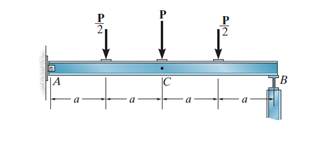Conjugate beam Problem no:5
Example 5: determine the displacement at C and the slope at point B for the beam shown in figure no: 1 considering EI a constant?
Figure 1
Figure 2
To determine the displacement at point C and the slope at B, we need to determine the moment at point C and the shear at point B in the conjugate beam. The conjugate beam will be loaded with M/EI of the real beam, so we need to draw M/EI for the real beam. To draw the M/EI diagram, we need to determine the reaction at point A and point B.
From the symmetry we can know that the reaction FA=FB=P. so the shear moment diagram will be as shown in the figure no:4.
From the symmetry the reaction FA=FB. So
To determine the displacement at point C, we need to determine the moment, we will take the section A-C. so using the equilibrium equations
























Comments
Post a Comment